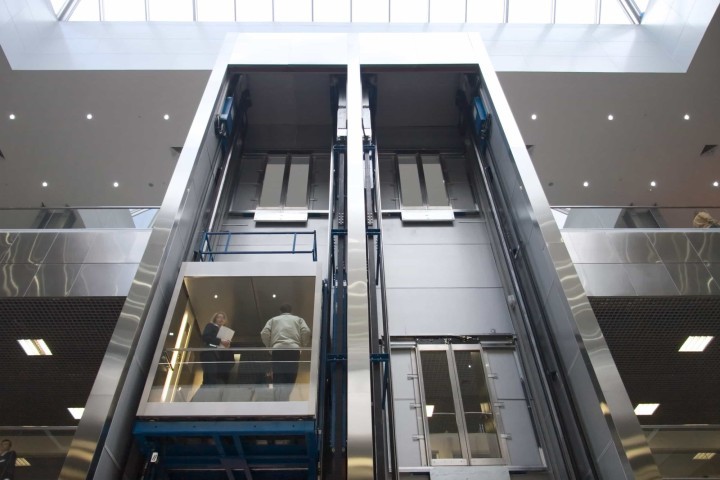Most business structures with two or more levels must have a lift installed. An elevator not only increases value by facilitating faster access up and down the building, but it also enables the building owner to comply with accessibility regulations.
Considerations for Design
Once the necessity for a lift (or lifts) has been established, there are a number of factors that specifiers should take into account, regardless of whether the lift will be the only one in the building or will be a second lift for extra access.
The first thing to take into account are the practical needs of the building itself, including the area inside the building, the number of floors, the available headroom and pit depth, and if there is space to construct or accommodate a lift shaft. Other considerations including safety and dependability, cost-effectiveness, matching existing décor, energy efficiency, and regulatory compliance will all have an impact on lift selections.
Size and capacity
Additionally, it's critical to take into account the predicted lift usage and traffic. Building Regulations specify the specifications for each type of lift, and Part M specifies the minimum lift size required for compliance, which is shown in table 1 below.
Traffic flow
The frequency of movement between floors during the day should be taken into account by specifiers. Are there periods of the day when the lift is most in demand, but less so elsewhere? How is the traffic situation? For instance, there can be traffic in an office at the beginning, middle, and end of the workday, but a lift at a retail establishment might be much more consistent throughout the day.
Lift passengers
Specifiers should think about who will use the lift and how they will use it. What kinds of individuals will be using the building? Can they utilise the elevator on their own? Will they be transporting bags or merchandise? In a nursing home or other setting where elderly people would use lifts independently, for example, the automatic buttons of a cabin-platform lift will be easier for users to use than the continual pressure (hold to run) needed by a regular platform lift.
When picking finishes and fittings, it's also important to consider the building's major users and intended usage. For instance, in social housing complexes, the need for a fire-fighting lift or a vandal-resistant finish may take precedence over aesthetics. Although BS 5655-6:2011 offers instructions on the selection, installation, and placement of new lifts, it is also regarded as best practise to use a similar system for existing structures.
Vertical Lift Types
It is likely that a lift of some form will be required to allow access to all in commercial buildings with two or more floors, or with variations in level inside the structure. We will examine the most common variations of both platform and passenger lifts.
Passenger Lifts
Passenger lift capacities can vary from 3 to 33 persons, with the average being about 8. Finishes and choices for technical details can be customised to your liking.
Passenger lifts (one or more) should be the automatic choice for any structure three stories or above. As such, it is important to give careful thought to the passenger lift's specifications; for instance, certain lifts can be used for firefighting and evacuation, while others may need to be vandal-proof.
When compared to platform lifts, passenger lifts provide more customisation possibilities and a wider range of flexibility, making them a better fit for more complicated project requirements. Adjusting the drive type for light or heavy usage, controlling the system using a keypad or swipe card, and setting up many lifts to work together are just a few examples. They are often set up in a shaft constructed especially for the purpose, however a glass or metal building may do. A passenger elevator may transport both those who are able to walk and those who are not. All buttons on the elevator's landing and in its cars are "latched" for autonomous operation.
Platform Lifts
Four categories can be used to classify platform lifts: -
- Low-speed lifts
- Enclosed platform lifts
- Open platform lifts
- Inclined platform lifts
Low Speed Lifts
These elevators are installed on the wall. This enables them to be put in shafts with significantly smaller pit and headroom dimensions, which lowers the cost of construction work and qualifies them for places where a passenger lift cannot be erected due to cost or practicality.
They function similarly to traditional passenger lifts but are only allowed to travel at a top speed of 0.15 m/s. Low-speed lifts generally transport up to five people and are smaller than passenger lifts, making them more suitable for low-rise applications (often two or three floors) when use is anticipated to be restricted.
One of the advantages is that it is comparable to elevators for passengers. The automated buttons, automatic carriage, and sliding doors on the landings make the lift easier to operate and more appealing. Additionally, there is no encroachment into the landings. Once inside, the person using the elevator will not observe any moving walls, as they do in other lifts that are subject to the Machinery Directive. Additionally, there is a larger potential for the finishes to be different.
Enclosed Platform Lifts
In low-rise structures without passenger elevators or in locations where installing one would be difficult, enclosed platform lifts are intended to offer disabled access. Subject to weight restrictions, they can also be utilised by passengers travelling with buggies and baggage. In a low-rise structure, they are intended to facilitate vertical mobility between levels (typically two to four floors).
Vertical enclosed platform lifts often fall into one of two categories:
Standard
A moving platform inside a vertical enclosure that is controlled by continuous pressure push buttons
Cabin
A cabin that moves inside of a vertical enclosure and is controlled by single touch buttons
Typically, these elevators can reach up to two or three levels. Although some are advertised as being able to serve up to six levels and/or 12 metres or more, careful thought should be given to the travel distance. It would take an average platform lift of 12 metres to go from top to bottom in 80 seconds or more, which is a long time for the user to press and hold the button, especially for the elderly or those who get tired fast.
Cabin platform lifts
Cabin walls, a ceiling, and a "virtual" or actual cabin door with an entrance/exit are all features of cabin platform lifts. As a result, automated controls rather than the constant-pressure (hold to run) controls found on traditional platform lifts can be added, providing the necessary safety measures are incorporated on the lift. As a result, the lift functions similarly to a passenger lift and does not require the user to hold down a button while travelling. Additionally, cabin platform lifts provide a wider variety of finishes.
Enclosed platform lifts
BS EN81-41:2010 is the appropriate British standard for platform lifts. There is no existing standard that addresses cabin platform lifts explicitly, however they must conform with the Machinery Directive. BS EN 81-42, a new standard for low-speed lifts, is being developed and is planned to encompass cabin platform lifts.
Enclosed platform lifts cannot provide the same degree of service as a passenger lift due to the Machinery Directive's speed limits, but they can be an affordable option in new construction or existing structures where the expense of installing a lift shaft is prohibitive.
Open platform lifts
When there is just a slight difference between the ground floor and the mezzanine, a public building could include an open or non-enclosed lifting platform (also known as a steplift) to safely transport people between floors. This makes their travel costs the lowest of any option. The buttons on these lifting platforms require constant pressure to work, and they meet the standards set out in BS 6440:2011. The standard, which is based on the Machinery Directive, provides for a maximum journey of 3m, although most only extend to 2m since going too far on an open platform may be unnerving. When travelling further than 2 metres, an enclosed platform lift is the safest and most comfortable option.
Inclined platform lifts
This additional platform lift design is often referred to as a wheelchair platform stairlift. On a rail, a platform moves up the stair's pitch line and folds up at the top and/or bottom. It enables upward and downward movement for a person who is sitting or in a wheelchair. Where a passenger or vertical lifting platform cannot be provided, they can be put in existing public buildings. They are frequently a last-ditch effort to address the issue of impaired access.






















